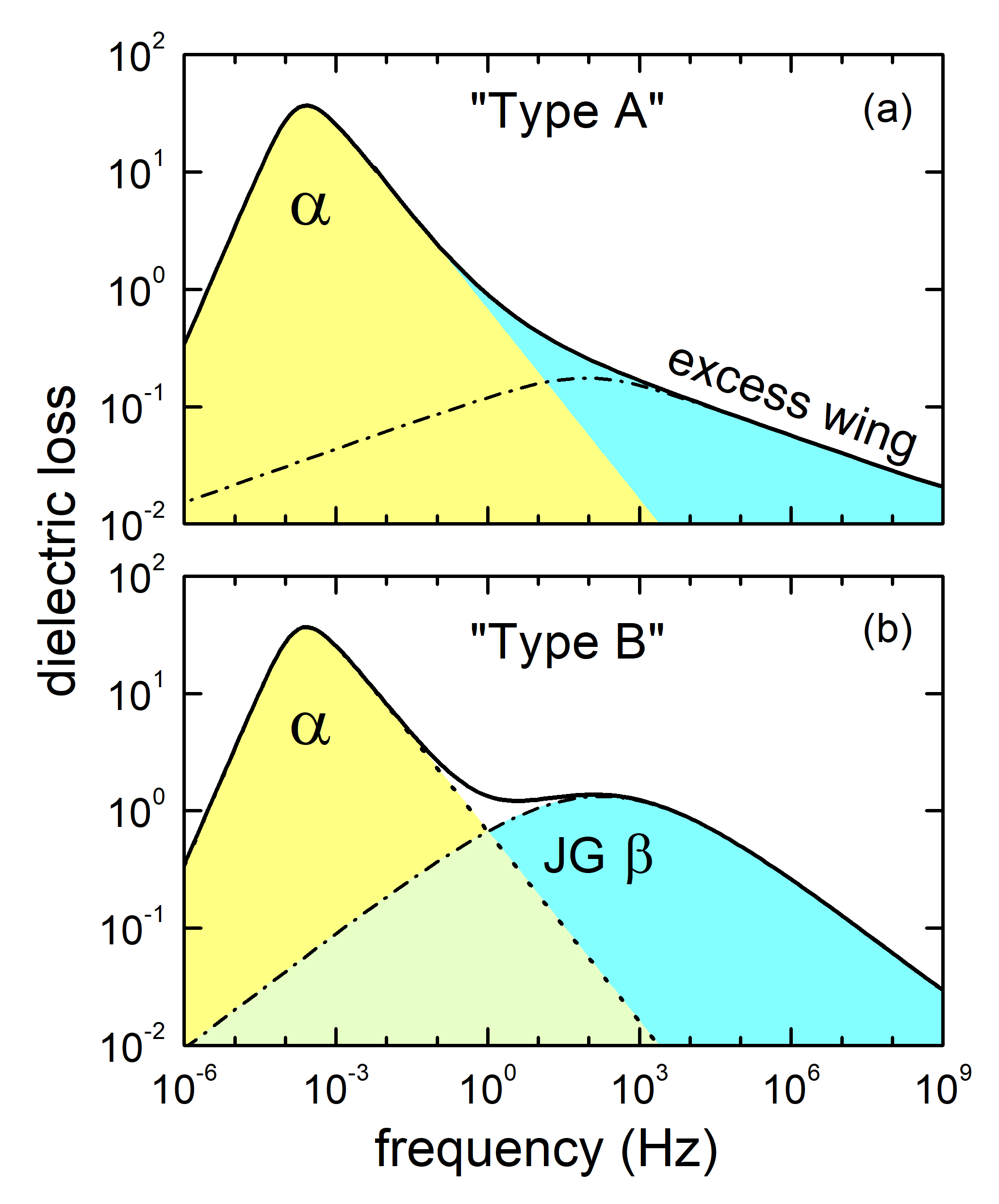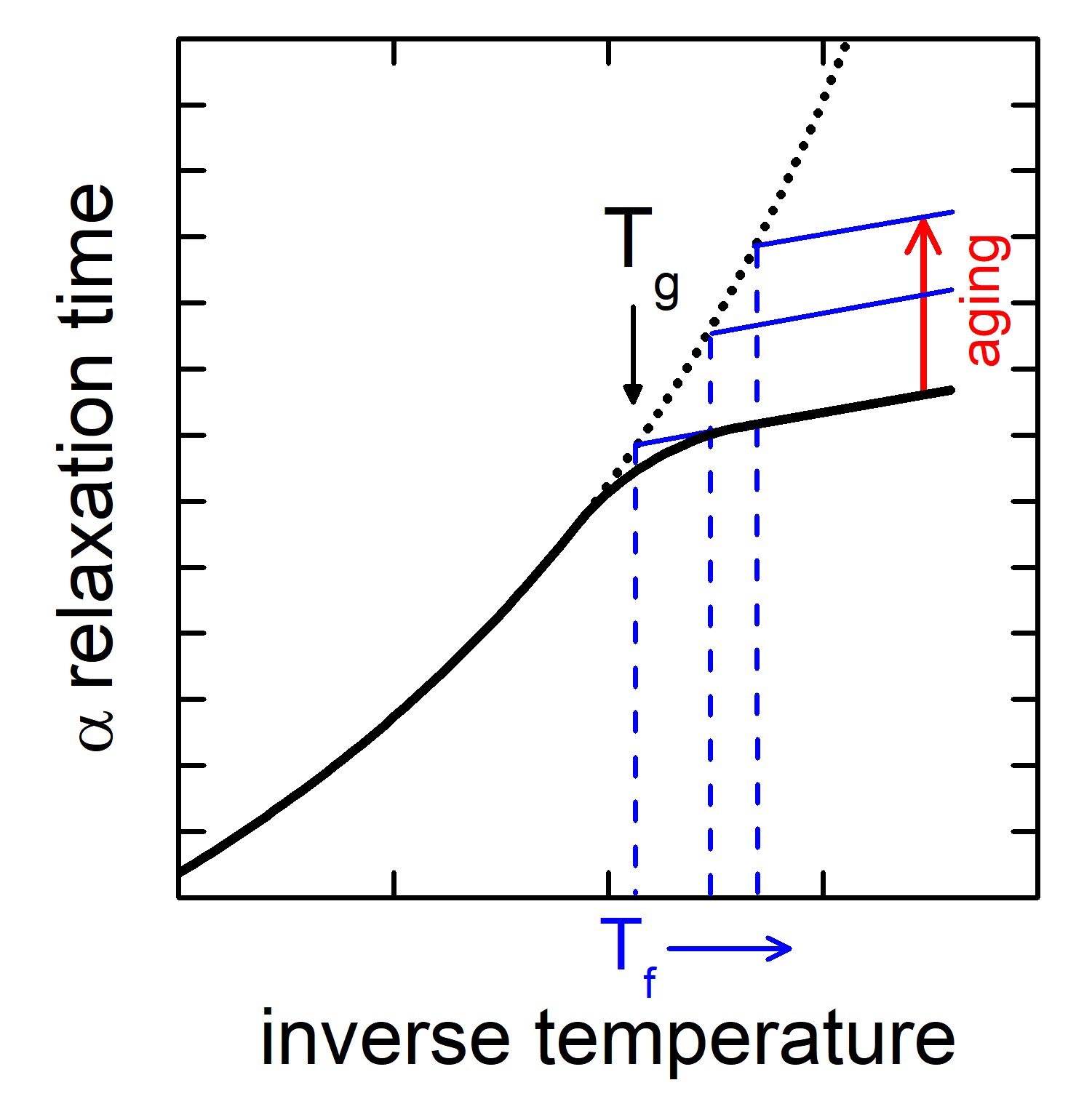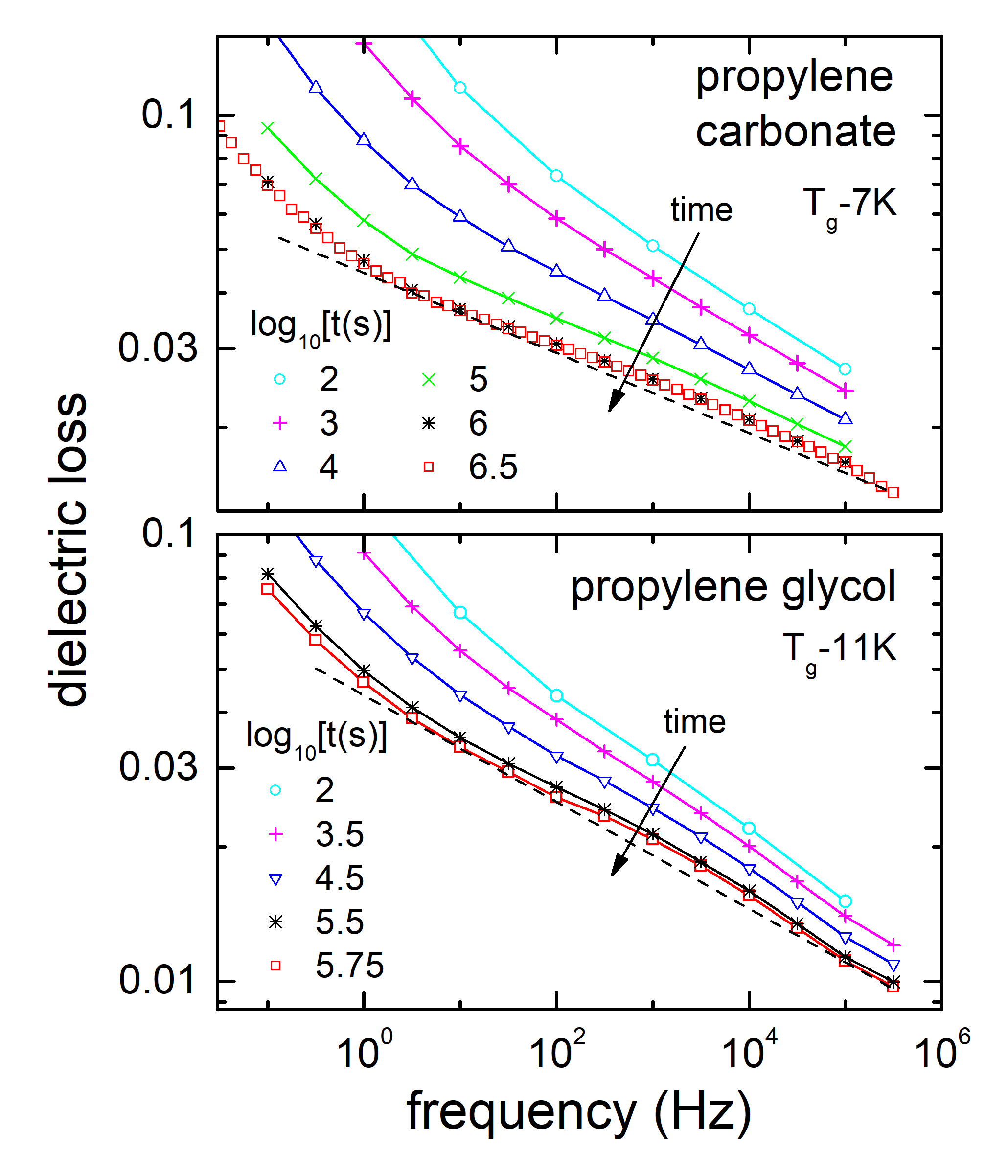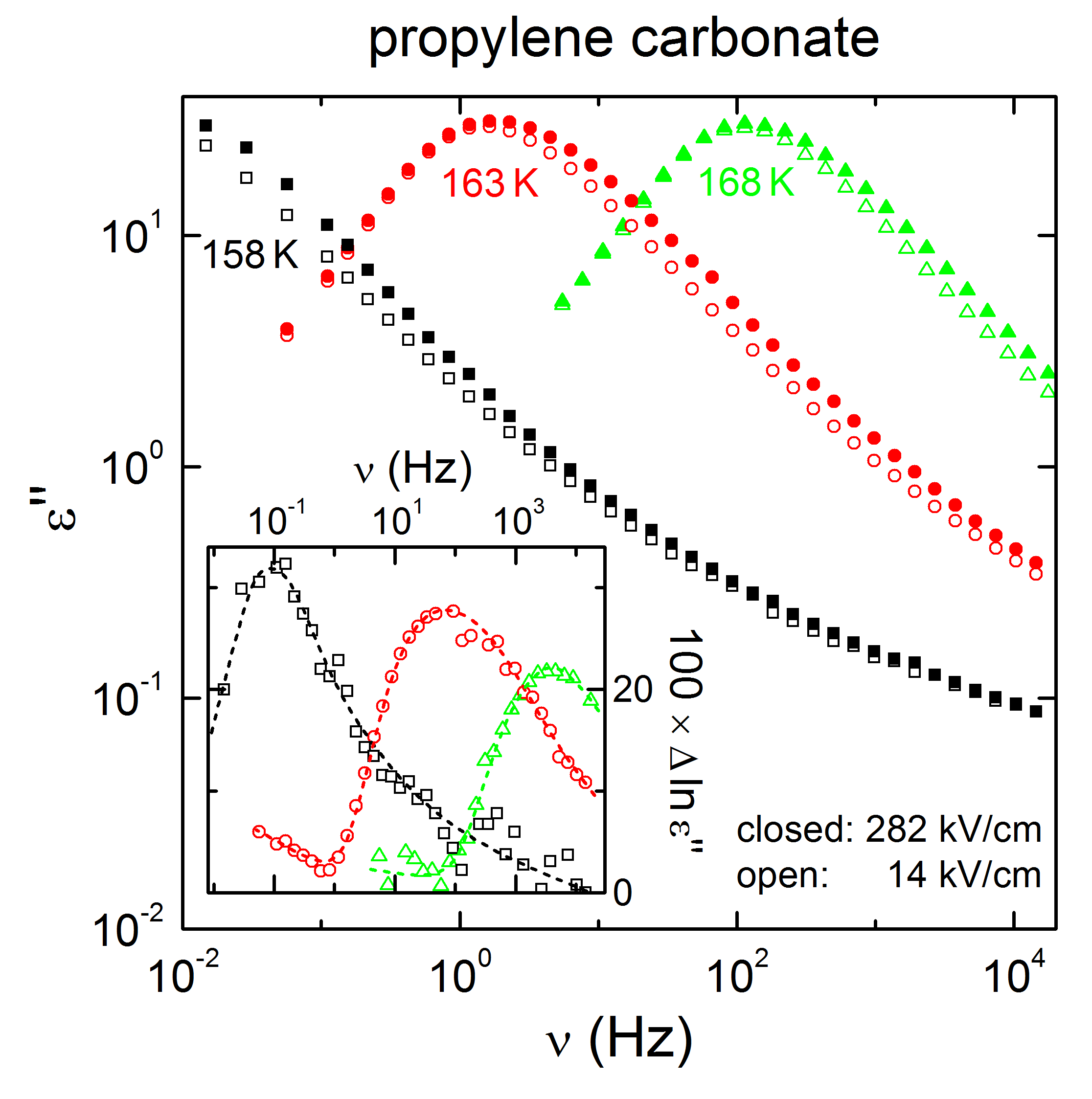EXCESS WING
1. Introduction
The α relaxation,
arising from the structural dynamics of the glass-forming particles
(molecules, ions,...), leads to a prominent peak in the dielectric-loss spectra of
dipolar glass formers (yellow area in Fig. 1 below). It can be described by various empirical formulae, e.g., the Cole-Davidson equation.
Its low- and high-frequency wings follow power laws with positive and negative exponent, respectively, which appear as straight lines in double-logarithmic plots of the loss spectra (Fig. 1).

|
Fig. 1: Frequency dependence of the dielectric loss at a temperature close to the glass transition
in a prototypical glass former with an excess wing (a) and in a glass former
with a canonical Johari-Goldstein (JG) β relaxation (b). The dash-dotted line in (a)
indicates how a JG relaxation can generate an excess wing.
|
However, when
measuring with sufficient precision, at the high-frequency flank of the α peak, deviations are revealed. In
many glassforming materials (sometimes termed "type A" [A. Kudlik et al., J. Mol. Structure 479, 201 (1999)]), a second, more shallow power law shows up (cyan region in Fig. 1a). It leads to an excess contribution at high frequencies which prompted us to term this phenomenon "excess wing" [1-3]. In another group of materials ("type B"), instead a second loss peak appears, termed β relaxation (Fig. 1b). While such secondary relaxation peaks can also arise from material-specific properties (e.g., intramolecular motions), the appearance of a β relaxation was shown by Johari and Goldstein to be a universal property of most glassforming materials [G.P. Johari and M. Goldstein, J. Chem. Phys. 53, 2372 (1970)]. Such relaxations thus nowadays are termed Johari-Goldstein (JG) relaxation.
The physical origins of both the excess wing and the JG relaxation are long-standing riddles of glass physics and their microscopic origin is controversially discussed. As first proven by our group via
aging measurements performed
in the excess-wing region [4,7], the excess wing is due to a secondary relaxation deeply submerged under the α peak (dash-dotted line in Fig. 1a). However, it still is quite controversial whether the excess wing is due a JG relaxation, partly hidden in the spectra below the dominating α-relaxation, or if it is due to an additional, separate relaxation process, not related to the JG relaxation.
2. Examples:
a) The excess wing - a secondary relaxation
The excess wing shows up as a second power law at the high-frequency flank
of the
α relaxation (Fig 1a). Could this simply be the right flank of a secondary relaxation peak,
which is strongly superimposed by the dominating α peak (dash-dotted line in Fig. 1a)? From type-B glass formers it is known that
α and β peak become more separated at low temperatures. Thus, we have investigated several
type-A glass formers at low temperatures, below the glass temperature Tg, hoping to see the
excess-wing power law developing into a peak or, at least, a shoulder. However, at low temperatures
aging effects
occur because the sample is not in thermodynamic equilibrium below Tg (Fig. 2). During aging,
the α-relaxation time τ(T) increases, which means that the α-peak frequency decreases and
should become more separated from the suggested β peak.

|
Fig. 2: Schematic plot showing the temperature dependence of the α-relaxation time τ (please note
the inverse temperature axis). During cooling, below the glass
temperature Tg the material no longer follows the equilibrium curve (dotted). Instead, τ(T) crosses over
to weaker temperature dependence (solid black line at T < Tg). However, when keeping the sample at a fixed temperature below
Tg for long time, aging can be observed, i.e., the sample approaches equilibrium and τ increases (red arrow).
This is accompanied by an increase of the so-called fictive temperature Tf (blue arrow).
|
Below, the excess-wing region is shown for two typical type-A glassformers,
measured below Tg at different aging times extending up to five weeks (!).
At these low temperatures, the α-relaxation peak is located at very low frequencies
and only shows up by the somewhat steeper increase of the loss towards low frequencies.
During aging, it moves further to the left and the power-law indeed develops into a
shoulder because it becomes less superimposed by the α peak. After maximum aging time,
the excess wing no longer is a simple power law, which
provides clear evidence for a secondary relaxation causing the excess wing [4,7].
Assuming that this secondary relaxation is the JG relaxation, the reason why it only leads to an
excess wing in type A glass formers, while it is clearly resolved in type B systems, can be
rationalized within the framework of the coupling model [6].

|
Fig. 3: Frequency-dependent dielectric loss of two dipolar glass formers for different aging times t.
After maximum aging times up to five weeks, the high-frequency power law representing the excess wing has
developed into a shoulder, evidencing a secondary relaxation.
The dashed lines represent power laws to demonstrate the significance of the shoulder after maximum aging.
[after: P. Lunkenheimer, R. Wehn, Th. Riegger, and A. Loidl,
Excess wing in the dielectric loss of glass formers: Further evidence for a β-relaxation,
J. Non-Cryst. Solids. 307-310, 336 (2002).]
|
For further details, see:
b) Nonlinear dielectric response at the excess wing of glass-forming liquids
Due to experimental limitations,
nonlinear dielectric spectroscopy
has been mostly restricted
to rather low frequencies and limited electrical fields, only revealing information on the so-called
α relaxation,
which governs, e.g., viscous flow. However, no meaningful information could be
obtained on the faster dynamic processes in glass forming matter, which have come into the focus of
glass physics during recent years. One of them is the so-called excess-wing, discussed in detail above.

|
Fig. 4: Frequency dependence of the dielectric loss of propylene carbonate, measured at low (open symbols)
and high electrical field (closed symbols), shown for three temperatures. In the inset, the difference
of the logarithm of the loss spectra shown in the main frame is plotted. The excess wing shows up as a
second, shallower decrease at the right flank of the peak (e.g., at frequencies larger than 10 Hz for
the 158K curve). In this region, surprisingly the low and high-field curves agree. This implies that,
in contrast to the main peak, there is no measurable nonlinear dielectric behaviour in the excess-wing region.
[from: Th. Bauer, P. Lunkenheimer, S. Kastner, and A. Loidl,
Nonlinear dielectric response at the excess wing of glass-forming liquids,
Phys. Rev. Lett. 110, 107603 (2013).]
|
We have performed measurements of the
nonlinear dielectric properties of prototypical
glass-forming liquids
up to relatively high frequencies, obtaining valuable information on the excess wing [10]. Surprisingly, we find a complete
absence of any nonlinear effects in this spectral region (see Fig. 4 for examples). This finding seems to support
long-standing assumptions of the absence of cooperativity in the molecular motions leading to the excess wing.
These results provide valuable information that helps understanding a prominent dynamic process, ubiquitous in
all kinds of glasslike matter (including, e.g.,
ionic conductors,
plastic crystals,
and metallic glasses). It also demonstrates that nonlinearity in a single material can differ considerably,
depending on the investigated spectral region, making further investigations of the nonlinear response in
extended frequency ranges highly desirable.
For further details, see:
3. Some relevant publications from our group:
| [1] |
Is there an excess wing in the dielectric loss of plastic crystals?
R. Brand, P. Lunkenheimer, U. Schneider, and A. Loidl,
Phys. Rev. Lett. 82, 1951 (1999).
[PDF]
|
| [2] |
Broadband dielectric spectroscopy on glass-forming propylene carbonate
U. Schneider, P. Lunkenheimer, R. Brand, and A. Loidl,
Phys. Rev. E 59, 6924 (1999).
[PDF]
|
| [3] |
Excess wing and high-frequency dynamics in plastic crystals
P. Lunkenheimer, R. Brand, U. Schneider, and A. Loidl,
Phil. Mag. B 79, 1945 (1999).
|
| [4] |
Excess wing in the dielectric loss of glass formers: A Johari-Goldstein β relaxation?
U. Schneider, R. Brand, P. Lunkenheimer, and A. Loidl,
Phys. Rev. Lett. 84, 5560 (2000).
[PDF]
|
| [5] |
Excess wing in the dielectric loss of glass-forming ethanol: A relaxation process
R. Brand, P. Lunkenheimer, U. Schneider, and A. Loidl,
Phys. Rev. B 62, 8878 (2000).
[PDF]
|
| [6] |
Nature and properties of the Johari-Goldstein β-relaxation in the equilibrium
liquid state of a class of glass-formers
K.L. Ngai, P. Lunkenheimer, C. Leon, U. Schneider, R. Brand, and A. Loidl,
J. Chem. Phys. 115, 1405 (2001).
[PDF]
|
| [7] |
Excess wing in the dielectric loss of glass formers: Further evidence for a β-relaxation
P. Lunkenheimer, R. Wehn, Th. Riegger, and A. Loidl,
J. Non-Cryst. Solids. 307-310, 336 (2002).
|
| [8] |
Dielectric spectroscopy of glass-forming materials: α-relaxation and
excess wing
P. Lunkenheimer and A. Loidl,
Chem. Phys. 284, 205 (2002).
|
| [9] |
Indications for an "excess wing" in metallic glasses from the mechanical loss modulus in
Zr65Al7.5Cu27.5
P. Rösner, K. Samwer, and P. Lunkenheimer,
Europhys. Lett. 68, 226 (2004).
|
| [10] |
Nonlinear dielectric response at the excess wing of glass-forming liquids
Th. Bauer, P. Lunkenheimer, S. Kastner, and A. Loidl,
Phys. Rev. Lett. 110, 107603 (2013).
[PDF]
|
| [11] |
Excess wing in glass-forming glycerol and LiCl-glycerol mixtures detected by neutron scattering
S. Gupta, N. Arend, P. Lunkenheimer, A. Loidl, L. Stingaciu, N. Jalarvo, E. Mamontov, and M. Ohl,
Eur. Phys. J. E 38, 1 (2015).
|
Homepage P. Lunkenheimer



